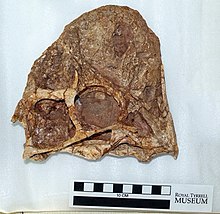Rinchenia
| Rinchenia | |
|---|---|

| |
| Skull of the holotype | |
| Scientific classification | |
| Domain: | Eukaryota |
| Kingdom: | Animalia |
| Phylum: | Chordata |
| Clade: | Dinosauria |
| Clade: | Saurischia |
| Clade: | Theropoda |
| Family: | †Oviraptoridae |
| Genus: | †Rinchenia Barsbold, 1997 |
| Type species | |
| †Rinchenia mongoliensis (Barsbold, 1986)
| |
| Synonyms | |
| |
Rinchenia (named after
History of discovery
During 1984, a nearly complete oviraptorid skeleton was discovered at the Altan Uul II (or Altan Ula II) locality of the highly fossiliferous Nemegt Formation, Gobi Desert. This newly collected specimen, MPC-D 100/32-A, included the skull and lower jaws in their entirety, nearly complete vertebral column, forelimbs with shoulder girdle, and partial hindlimbs with pelvic girdle. Later on, Mongolian paleontologist Rinchen Barsbold in 1986 used the specimen to erect and describe a new species of Oviraptor: Oviraptor mongoliensis.[1] Barsbold in 1997 assigned a new genus for the specimen, namely Rinchenia. Although concluding that it was distinctly different from Oviraptor in both skull and skeleton characters, Barsbold did not include a formal diagnosis for this new taxon.[2] Halszka Osmólska with colleagues in 2004 during their large revision of several dinosaur clades preferred the combination R. mongoliensis over the previously named O. mongoliensis, also regarding the latter as a synonym.[3]
In 2018, Gregory F. Funston and team conducted a comprehensive revision of the at-the-time known oviraptorosaur taxa across the
Description

Rinchenia was a small-sized oviraptorid, estimated at 1.7 m (5.6 ft) and a body mass of about 25 kg (55 lb).[6] Several features of its skeleton, especially in the skull, show it to be distinct from Oviraptor. Its skeleton was more lightly built and less robust than that of Oviraptor, and while the crest of Oviraptor is indistinct because of poor fossil preservation, Rinchenia had a well-preserved, highly developed, cassowary-like casque/dome which incorporated many bones in the skull that are free of the crest in Oviraptor.[4]
See also
References
- ^ Barsbold, R. (1986). "Хищные динозавры овирапторы" [Predatory dinosaurs oviraptors]. In Vorobyeva, E. I. (ed.). Herpetological Research in the Mongolian People's Republic (in Russian). Moscow: Academia Nauk SSSR. pp. 210–223.
- ISBN 0080494749.
- ISBN 0520242092.
- ^ .
- ^ Funston, G. F. (2019). "Chapter 4 – Oviraptoridae" (PDF). Anatomy, systematics, and evolution of Oviraptorosauria (Dinosauria, Theropoda) (PhD thesis). University of Alberta. pp. 463−479.
- ISBN 9780691167664.
